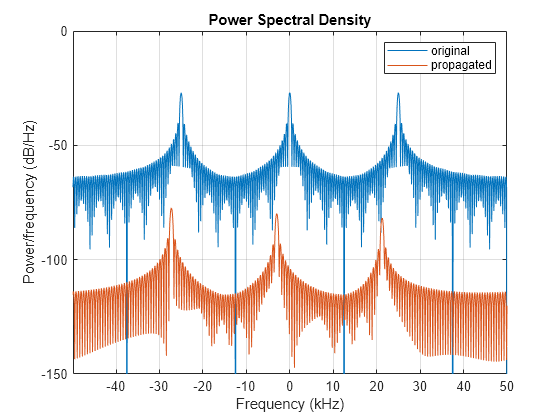phased.WidebandFreeSpace
Wideband free-space propagation
Description
The phased.WidebandFreeSpaceSystem object™ models wideband signal propagation from one point to another in a
free-space environment. The System object applies range-dependent time delay, gain adjustment, and phase shift to
the input signal. The object accounts for Doppler shift when either the source or
destination is moving. A free-space environment is a boundary-free medium with a speed
of signal propagation independent of position and direction. The signal propagates along
a straight line from source to destination. For example, you can use this object to
model the two-way propagation of a signal from a radar to a target.
For nonpolarized signals, the
System object lets you propagate signals from a single point to multiple points or from
multiple points to a single point. The object does not support
mutiple-point–to–multiple-point propagation.
When propagating a round trip signal in free space, you can use one WidebandFreeSpace
System object to compute the two-way propagation delay. Alternatively, you can use two
separate WidebandFreeSpace System objects to compute
one-way propagation delays in each direction. Due to filter distortion, the total round
trip delay when you employ two-way propagation can differ from the delay when you use
two one-way phased.WidebandFreeSpace System objects.
It is more accurate to use a single two-way phased.WidebandFreeSpace
System object. To set this option, use the TwoWayPropagation
property.
To compute the propagated signal in free space:
Create the
phased.WidebandFreeSpaceobject and set its properties.Call the object with arguments, as if it were a function.
To learn more about how System objects work, see What Are System Objects?
Creation
Syntax
Description
widebandFreeSpace = phased.WidebandFreeSpacewidebandFreeSpace.
widebandFreeSpace = phased.WidebandFreeSpace(Name=Value)OperatingFrequency=4e8 sets the operating frequency to
4e8.
Properties
Usage
Description
propSig = widebandFreeSpace(sig,sigOrig,sigDest,origVel,destVel)propSig, when a wideband
signal sig propagates through a free-space channel from the
sigOrig position to the sigDest
position. Either the sigOrig or
sigDest arguments can specify more than one point but
you cannot specify both as having multiple points.
Input Arguments
Output Arguments
Object Functions
To use an object function, specify the
System object as the first input argument. For
example, to release system resources of a System object named obj, use
this syntax:
release(obj)
Examples
More About
References
[1] Proakis, J. Digital Communications. New York: McGraw-Hill, 2001.
[2] Skolnik, M. Introduction to Radar Systems, 3rd Ed. New York: McGraw-Hill, 2001.
Extended Capabilities
Version History
Introduced in R2015b
See Also
twoRayChannel (Radar Toolbox) | phased.FreeSpace | phased.WidebandRadiator | phased.WidebandCollector | phased.RadarTarget | fspl
